#European Association of Archaeologists
Explore tagged Tumblr posts
Text
youtube
#EAABelfast#EAA2023#European Association of Archaeologists#European Association of Archaeologists Annual Meeting#archaeologist#archaeology#gibraltar#art history#rock art#art#cave art#cave painting#cave paintings#bernie taylor#before orion#Black Hills#Lakota#Native American#Youtube
1 note
·
View note
Text
"EUROPEANS ATE GROUND-UP EGYPTIAN MUMMIES!!!! ALL THE TIME!!!"
sounds much more dramatic than
"Europeans sometimes consumed ground-up Egyptian mummies, or fluid found inside the chest cavities of mummies, or a type of tree resin that became associated with mummies because it kind of looked like the bitumen used in the embalming process, or the dried and ground flesh of very specific European dead- most likely a bit of all of the above at various times in various places. but it's hard to say what the proportion of each was- and at least one early Middle Eastern physician, Abd al-Latif al-Baghdadi from modern-day Iran, also advised the use of the Body Cavity Liquid variety hundreds of years before the first documented use of mummy by Europeans. so it was a medicinal thing in the areas from whence the mummies came, too. unsurprising seeing as a lot of cultures- including Europeans -have done Corpse Medicine with their own people for centuries. there was also been pushback against the medicinal use of mummies in Europe since at least the 16th century; it remains unclear how popular the notion was at any given time. so the answer to Is This A Good Symbol For The Effects of European Colonialism In Egypt remains a resounding 'ehhh...?'"
"because the whole idea is, is it not, that Europeans were literally consuming the dead bodies of a non-European people who would have had no reason to sell their dead without a European market. and that's kind of true! there was a market that created a demand! but they were also already putting the bodies to these uses closer to home before Europeans started, because this whole thing began with both Arab and European doctors misinterpreting other Arab doctors who were talking about the medicinal qualities of tree resin. so really it's not as simple a situation as we might like to believe."
"and Mummy Brown paint is like this whole other situation where it was supposed to be made from ground-up mummies but often wasn't because Cost-Cutting, and a lot of artists didn't really like it anyway, and others used it thinking the name only referred to the color, and one time Edward Burne-Jones attempted an Egyptian funeral for a tube of Mummy Brown paint because he was so horrified with the origins, so while that's a more straightforward as an Oh Shit Violent Colonialism situation, people merrily waltzing into shops and buying one tube of Dead Egyptian Person, please, my good man! wasn't quite as widespread as one might now think"
"for me, the more compelling image of Europe Fucking Egypt Over is that of a white archaeologist peering curiously into a pit where Egyptian people are working tirelessly to excavate a tomb, their names to be lost to history in favor of whatever rich white person they toiled for. even that image is not without complicating factors- I, imagining it, am a white woman who cannot ask those Egyptian men what they think and feel about all their role in all this -but to me it seems more reliable than the VERY complex and often misinterpreted history of the mummy trade, even as I understand it after like an hour of research"
"on the OTHER HAND, does it even matter if people in the Middle East were already doing mummy medicine, when Europeans increased demand? does it even matter if Europeans felt bad or at least grossed out about Mummy Brown paint or if it wasn't ~always~ real mummies? maybe it doesn't! maybe my instincts as a history worker to say It's More Complicated are clouding my judgment on the nature of colonialism! or maybe they aren't! or maybe different people will think I'm right or think I'm full of shit and that's just the nature of doing public history on The Tungles!"
"anyway I have COVID and should probably go to bed now"
"this article and the Wiki page for Mummia are very well-sourced"
937 notes
·
View notes
Note
Hey, would you be willing to elaborate on that "disappearance of the Anasazi is bs" thing? I've heard something like that before but don't know much about it and would be interested to learn more. Or just like point me to a paper or yt video or something if you don't want to explain right now? Thanks!
I’m traveling to an archaeology conference right now, so this sounds like a great way to spend my airport time! @aurpiment you were wondering too—
“Anasazi” is an archaeological name given to the ancestral Puebloan cultural group in the US Southwest. It’s a Diné (Navajo) term and Modern Pueblos don’t like it and find it othering, so current archaeological best practices is to call this cultural group Ancestral Puebloans. (This is politically complicated because the Diné and Apache nations and groups still prefer “Anasazi” because through cultural interaction, mixing, and migration they also have ancestry among those people and they object to their ancestry being linguistically excluded… demonyms! Politically fraught always!)
However. The difficulties of explaining how descendant communities want to call this group kind of immediately shows: there are descendant communities. The “Anasazi” are Ancestral Purbloans. They are the ancestors of the modern Pueblos.
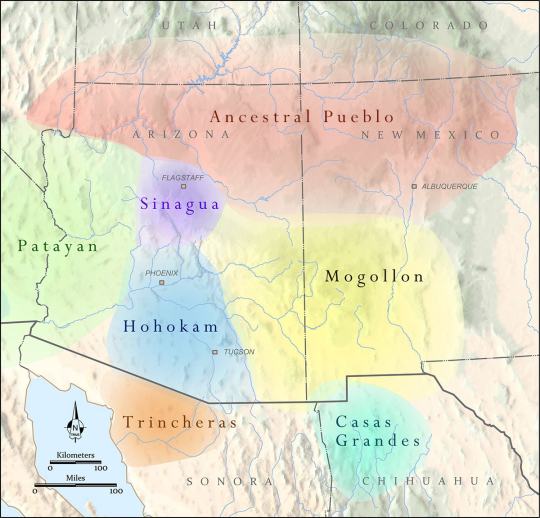
The Ancestral Puebloans as a distinct cultural group defined by similar material culture aspects arose 1200-500 BCE, depending on what you consider core cultural traits, and we generally stop talking about “Ancestral Puebloan” around 1450 CE. These were a group of people who lived in northern Arizona and New Mexico, and southern Colorado and Utah—the “Four Corners” region. There were of course different Ancestral Pueblo groups, political organizations, and cultures over the centuries—Chaco Canyon, Mesa Verde, Kayenta, Tusayan, Ancestral Hopi—but they generally share some traits like religious sodality worship in subterranean circular kivas, residence in square adobe roomblocks around central plazas, maize farming practices, and styles of coil-and-scrape constructed black-on-white and black-on-red pottery.
The most famous Ancestral Pueblo/“Anasazi” sites are the Cliff Palace and associated cliff dwellings of Mesa Verde in southwestern Colorado:

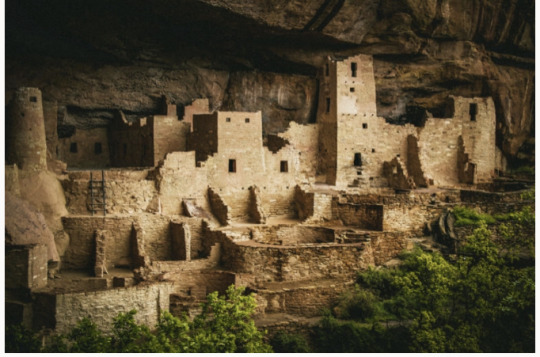
When Europeans/Euro-Americans first found these majestic places, people had not been living in them for centuries. It was a big mystery to them—where did the people who built these cliff cities go? SURELY they were too complex and dramatic to have been built by the Native people who currently lived along the Rio Grande and cited these places as the homes of their ancestors!
So. Like so much else in American history: this mystery is like, 75% racism.
But WHY did the people of Mesa Verde all suddenly leave en masse in the late 1200s, depopulating the whole Mesa Verde region and moving south? That was a mystery. But now—between tree-ring climatological studies, extensive archaeology in this region, and actually listening to Pueblo people’s historical narratives—a lot of it is pretty well-understood. Anything archaeological is inherently, somewhat mysterious, because we have to make our best interpretations of often-scant remaining data, but it’s not some Big Mystery. There was a drought, and people moved south to settle along rivers.
There’s more to it than that—the 21-year drought from 1275-1296 went on unusually long, but it also came at a time when the attempted re-establishment of Chaco cultural organization at the confusingly-and-also-racist-assuption-ly-named Aztec Ruin in northern New Mexico was on the decline anyway, and the political situation of Mesa Verde caused instability and conflict with the extra drought pressures, and archaeologists still strenuously debate whether Athabaskans (ancestors of the Navajo and Apache) moved into the Four Corners region in this time or later, and whether that caused any push-out pressures…
But when I tell people I study Southwest archaeology, I still often hear, “Oh, isn’t it still a big mystery, what happened to the Anasazi? Didn’t they disappear?”
And the answer is. They didn’t disappear. Their descendants simply now live at Hopi, Zuni, Taos, Picuris, Acoma, Cochiti, Isleta, Jemez, Laguna, Nambé, Ohkay Owingeh, Pojoaque, Sandia, San Felipe, Santa Clara, San Ildefonso, Tamaya/Santa Ana, Kewa/Santo Domingo, Tesuque, Zia, and Ysleta del Sur. And/or married into Navajo and Apache groups. The Anasazi/Ancestral Puebloans didn’t disappear any more than you can say the Ancient Romans disappeared because the Coliseum is a ruin that’s not used anymore. And honestly, for the majority of archaeological mysteries about “disappearance,” this is the answer—the socio-political organization changed to something less obvious in the archaeological record, but the people didn’t disappear, they’re still there.
446 notes
·
View notes
Text
How history directly plays a part in the colonization of Palestine
"The modern claim that Joseph's Tomb is directly related to the biblical Joseph appears to have emerged as a result of claims by William Cooke Taylor in the 1830s. Cooke was an Irish journalist traveling in the area motivated by interest in biblical history but with no expertise in the field. Although in his writings he claims the site was believed be the tomb of the patriarch and that all the religions agreed as much, no other geographers who ventured into the area in the decades that followed reported anything of the sort. And it is unclear from his writings what local Palestinians, the people who were actually living in and around the shrine and worshipping there, believed about the shrine. British geographers subsequently took up Taylor's claim, however, and over the years it was forgotten that it had been more or less made up based on conjecture.
But the claims of biblical archaeologists had a strong role in how the Zionist movement would come to understand and conceive of the landscape.6 As European Jews migrated to Palestine in the first half of the twentieth century, they drew upon biblical archeology's claims. They adopted archeologists' claims that Palestinian holy sites were directly linked to ancient biblical figures. In many cases, they focused on occupying those sites in order to legitimize the colonial endeavor by giving it a sense of deeper history. In many cases, this would mean evicting the Palestinians who actually frequented these holy sites.
When Israel occupied the West Bank in 1967, religious Zionists began flocking to Joseph's Tomb. The tomb, which was previously open to pilgrims of all faiths, began to fall under exclusively Jewish control. As growing numbers of armed Jewish settlers were escorted to the tomb under military escort, the area became increasingly viewed with apprehension by Palestinians living around the site. In 1975, the Israeli military banned Palestinians – that is, the Samaritans, Muslims, and Christians living around the site – from visiting, a ban that has remained in place until this day. When I visited in summer 2015, the tomb was shut closed, but a sympathetic guard allowed me and a friend to look around, under his close watch.
Unsurprisingly, the ban has ignited intense anger over the years. This is true particularly given that frequent visits by Jewish settlers to the shrine are accompanied by hundreds of Israeli soldiers, who enter the area and run atop the rooftops of local Palestinians to “secure” the tomb. As a result, Joseph's Tomb has increasingly become associated with the Israeli military and settlement movement in the eyes of Palestinians. Its presence has become an excuse for frequent military incursions that provoke clashes and lead to arrests and many injuries in the neighborhood.7
Some fear that Israelis will attempt to take over the shrine to build an Israeli settlement around it. This fear is not unfounded, given the fact that Israeli settlers have done exactly that all across the West Bank in places they believe are connected in some way to Jewish biblical history. The notoriously violent Jewish settlements in Hebron, for example, were built there due to the location of the Tomb of the Patriarchs in that southern West Bank town. Following the initial years of settlement, settlers even managed to convince Israeli authorities to physically divide the shrine – which is holy to local Palestinians – and turn the whole area into a heavily-militarized complex. Other shrines have become excuses for the Israeli military to build army bases inside Palestinian towns, like Rachel's Tomb in Bethlehem – which is surrounded by twenty-foot high concrete walls on three sides to block Palestinian access. The village of Nabi Samwel near Jerusalem, meanwhile, was demolished in its entirety to provide Jewish settlers access to the tomb at its heart."
—Excerpt from Why Do Palestinians Burn Jewish Holy Sites? The Fraught History of Joseph's Tomb by Alex Shams
787 notes
·
View notes
Text

16th-Century Coin Hoard Unearthed in Poland
A father-and-son metal detecting duo discovered a "priceless" treasure trove of 17 rare historic coins.
Sławomir and Szymon Milewscy found the coins near Pomiechówek, a village in the Mazovia region of east-central Poland.
The silver coins, dated to the 16th and 17th centuries, came to light during a search by the Polish Association of Prospectors in collaboration with the Triglav Historical and Research Association. The search aimed to uncover evidence of a road from the time of the Roman Empire, but the effort resulted in a very different kind of discovery.


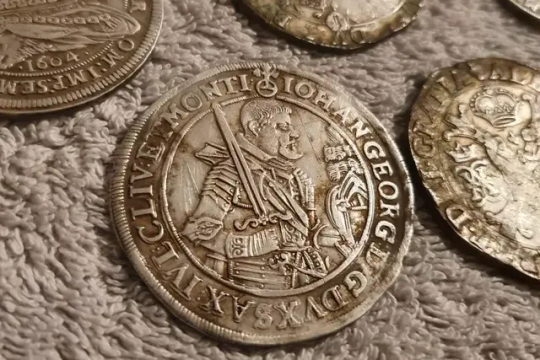
"We have a treasure. We didn't expect this at all," the prospectors association said in a on November 3 post.
"We will start with the historical value—this one for us is priceless," the association said in another post on November 4.
While Piotr Duda, an archaeologist from the Triglav Historical and Research Association, also noted that the coins' historical value is "indescribable," their material value is estimated to be around half a million Polish zlotys—equivalent to roughly $122,000.
"This is probably one of the largest treasures of this type discovered so far in Poland, and certainly in Mazovia. Yes, in recent years, deposits of coins from various historical eras have emerged, but not from the 16th and 17th centuries," Duda told Science in Poland.
We knew that these were silver coins and their value could be high, but when we started looking at them, we were rubbing our eyes with amazement. It is simply unbelievable," he said.



The coin hoard consists of thaler and paragon coins, which were large silver coins used in Europe from the 16th to the 18th centuries.
The thaler, originating in the Holy Roman Empire, was widely circulated and became the model for many currencies. It was known for its stability and high silver content. The English word "dollar" is also derived from the name.
The patagon, meanwhile, was a similar large silver coin primarily minted in the Spanish Netherlands. This territory included parts of modern-day Belgium, Luxembourg, and the Netherlands during the late 16th and 17th centuries. These coins were widely used in European trade and exported to Spanish colonies, making them valuable in international commerce.
One of the coins—a 1630 thaler depicting Sigismund III Vasa, king of Poland (1587–1632) and Sweden (1592–99)—is a particularly rare Thaler. An identical coin, but in much worse condition, was sold at auction last year for more than 86,000 Polish zlotys, or around $21,000.
The newly discovered treasure will now be transferred to the Mazovian Voivodeship Conservator of Monuments and eventually placed in a museum.
By Aristos Georgiou.



#16th-Century Coin Hoard Unearthed in Poland#Pomiechówek#silver#silver coins#paragon coins#collectable coins#metal detecting#ancient artifacts#archeology#archeolgst#history#history news#ancient history#ancient culture#ancient civilizations#Sigismund III Vasa
77 notes
·
View notes
Text
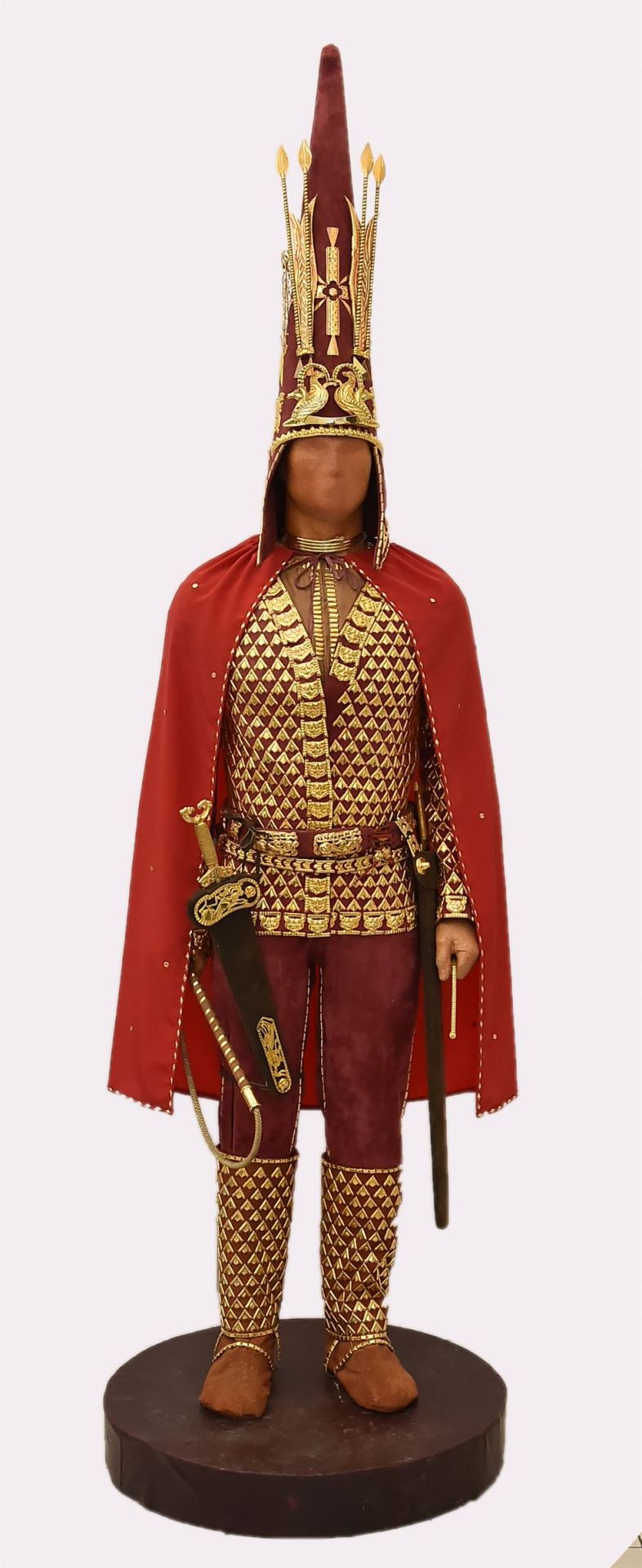

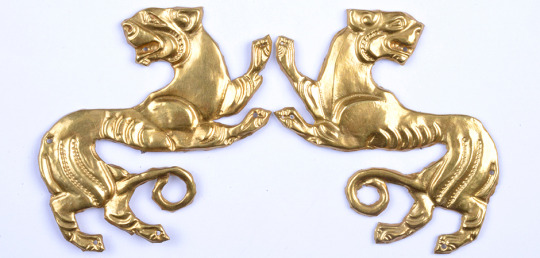
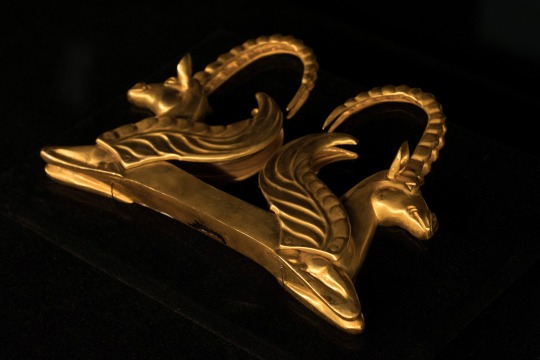
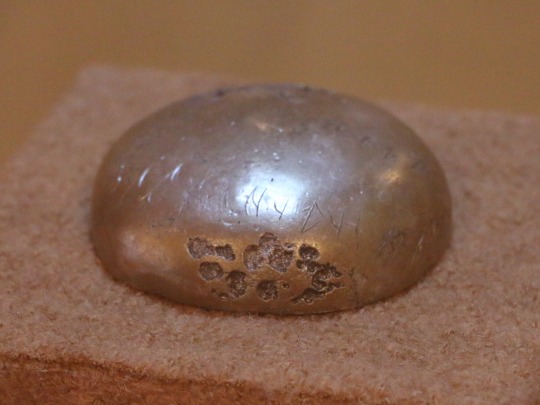

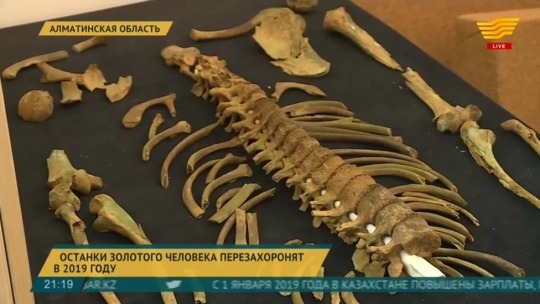


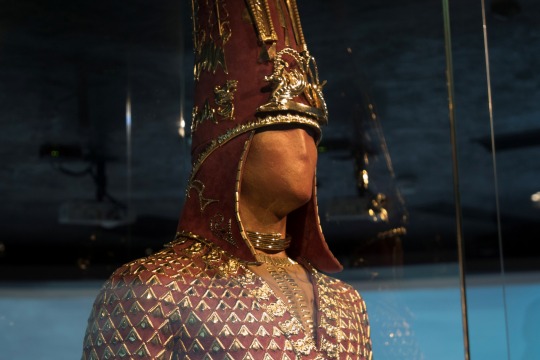
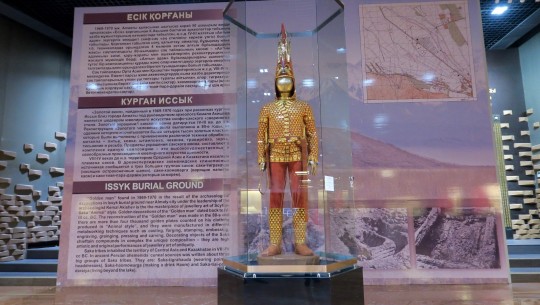

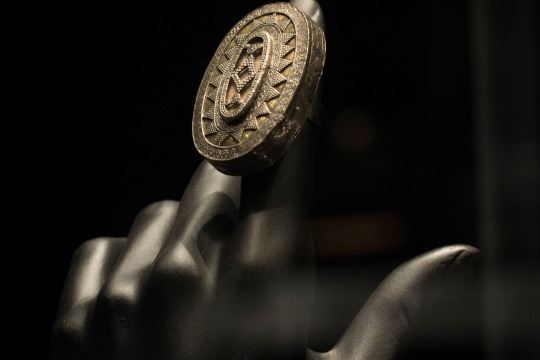
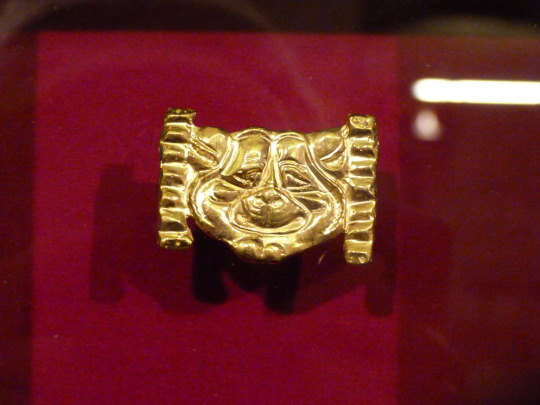
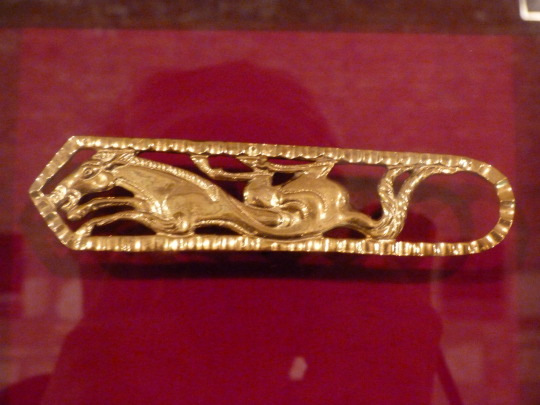
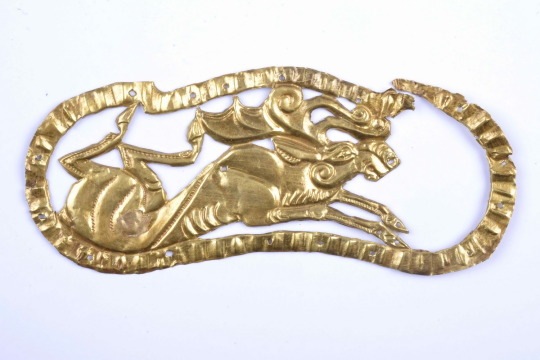
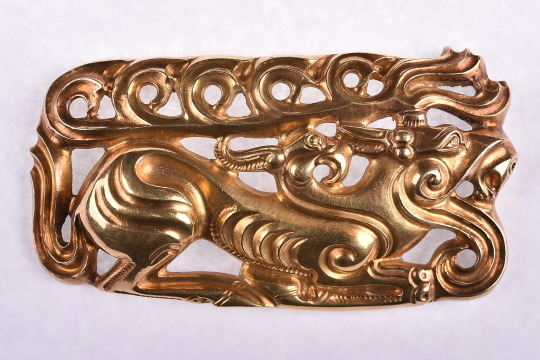
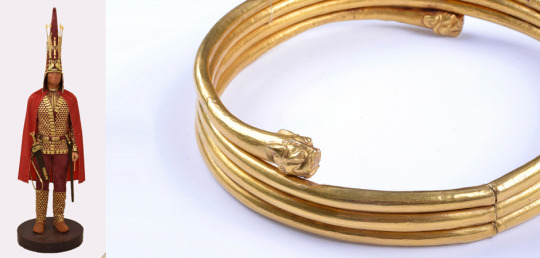
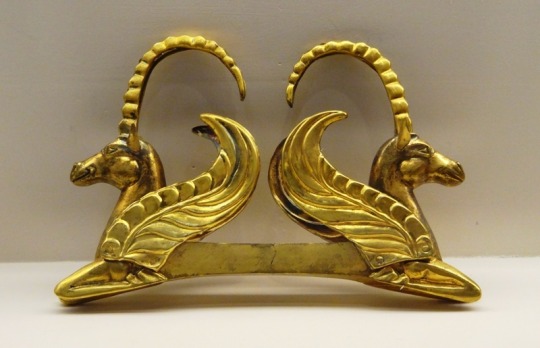
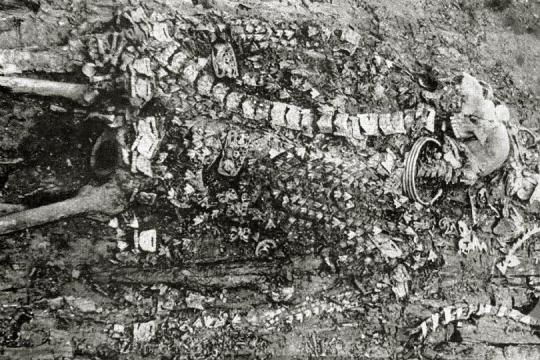


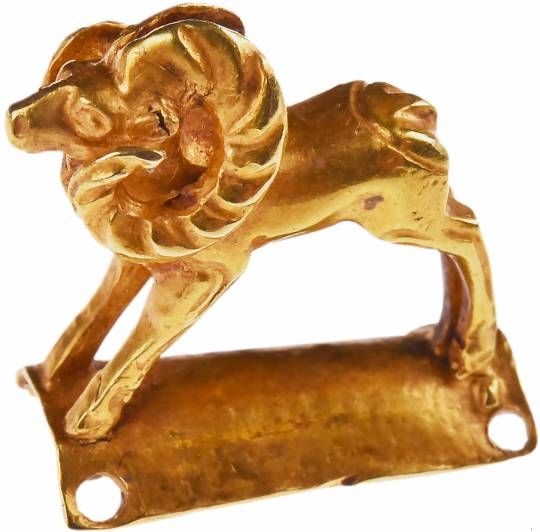

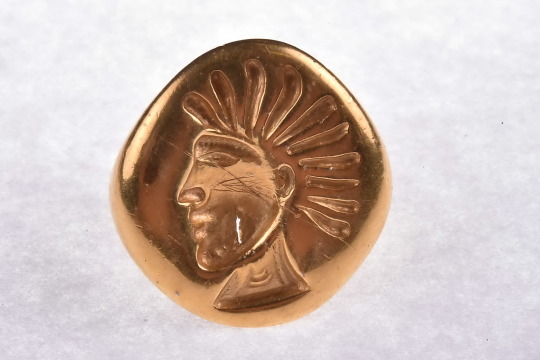
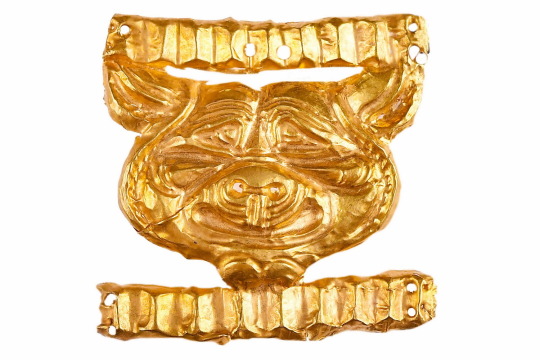
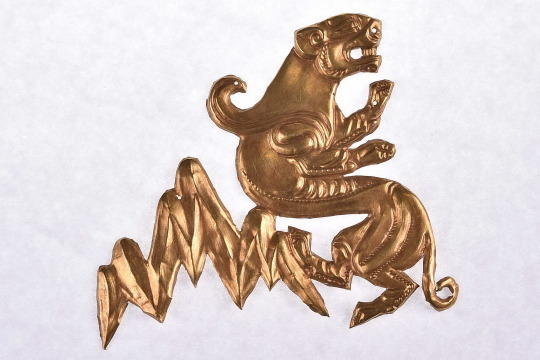

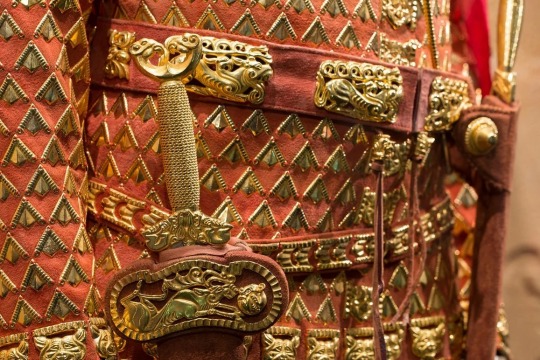
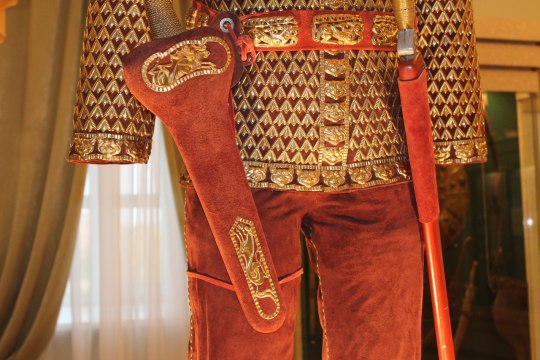
The Issyk kurgan of the 'Golden Man' 6th-3rd C. BCE
"The Issyk kurgan, in south-eastern Kazakhstan, less than 20 km east from the Talgar alluvial fan, near Issyk, is a burial mound discovered in 1969. It has a height of six meters and a circumference of sixty meters. It is dated to the 4th or 3rd century BC. A notable item is a silver cup bearing an inscription. The finds are on display in Nur-Sultan. It is associated with the Saka peoples.
The burial complex located on the left bank of the Issyk Mountain River, 50 kilometers to the East to the Almaty city. The unique archaeological complex found by a small group of Soviet scientists led by archaeologist Kemal Akishevich Akishev in 1969. The burial ground consists of 45 large Royal mounds with a diameter of 30 to 90 and a height of 4 to 15 meters. The Issyk barrow is located in the Western half of the burial ground. Its diameter is 60 meters and its height is 6 meters.
Situated in eastern Scythia just north of Sogdiana, the kurgan contained a skeleton, warrior's equipment, and assorted funerary goods, including 4,000 gold ornaments. Although the sex of the skeleton is uncertain, it may have been an 18-year-old Saka (Scythian) prince or princess.
The richness of the burial items led the skeleton to be dubbed the "golden man" or "golden princess", with the "golden man" subsequently being adopted as one of the symbols of modern Kazakhstan. A likeness crowns the Independence Monument on the central square of Almaty. Its depiction may also be found on the Presidential Standard of Nursultan Nazarbayev.
There were two burials in the grave complex: the Central one and the Southern one (to one side). Unfortunately the Central burial site had been robbed but the side grave was undisturbed. The burial chamber in the side grave was constructed from spruce logs. The tomb and its contents remained intact and buried. The skeletal remains were found in the Northern half of the chamber. More than 4,000 gold items were found in the chamber, as well as iron sword and dagger, a bronze mirror, vessels made of clay, metal and wood, shoes, headdresses, gold rings, statuettes, bronze and gold weapons, and an inscribed silver bowl dating from the 6th to 5th century BCE. Many clothing ornaments made of gold, a headdress and shoes were found on and under the remains. Next to the remains were an arrow with a gold tip, a whip (the handle of which was wrapped with a wide ribbon of gold in a spiral pattern) and a bag containing a bronze mirror and red paint. Scientific research, particular that of the anthropologist O. I. Ismagulov, shows that the remains belong to a member of the Saka peoples of Semirecheye, who have a European appearance with an admixture of Mongoloid features. The age of the body at death is estimated at 16–18 years, and its sex is indeterminate. The form of clothing and method of burial suggest that "The Golden Man" was a descendant of a prominent Saks tribe leader, or a member of the Royal family.
A text was found on a silver bowl in Issyk kurgan, dated approximately VI BC. The context of the burial gifts indicates that it may belong to Saka tribes.
The Issyk inscription is not yet certainly deciphered, and is probably in a Scythian dialect, constituting one of very few autochthonous epigraphic traces of that language. János Harmatta, using the Kharoṣṭhī script, identified the language as a Khotanese Saka dialect spoken by the Kushans.
The Wikipedia page has a possible (partial?) deciphering of the Issyk inscription as: "The vessel should hold wine of grapes, added cooked food, so much, to the mortal, then added cooked fresh butter on".
...
Kazakhstan will rebury an iconic ancient warrior in a time capsule this year (2019), in the hope that future generations will be able to establish who he really was, Kazakh TV reports.
Since independence in 1991, he has become a symbol of Kazakhstan's national heritage. His armour takes pride of place in the national museum in Astana, and tours the world as a calling card of Kazakh culture.
The bones were only rediscovered recently at a forensic institute, stored in a cardboard box with a scribbled note reading "The Golden Man, May He Rest in Peace".
"We know his age and social status, while DNA tests could provide us with exhaustive data," researcher Dosym Zikiriya told Kazakh TV.
But Yermek Zhasybayev of the Issyk Museum held out little hope of this. "The bones are in a bad state. They have been kept in a cardboard box for 50 years and been exposed to all sorts of bacteria and viruses, including modern ones. It is now impossible to get a full DNA transcription - if only we had the skull, or just one tooth," he told the TV channel.
Scientists say their only hope is to seal the remains in a special time capsule to prevent any further decomposition, so that technological advances might allow future generations to glean more information about the long-dead warrior.
In recognition of the Golden Man's status, the capsule will be "ceremonially buried in keeping with ancient royal traditions", Kazakh TV said.
Archaeologists are confident that the remains date back to at least the 2nd-3rd century BCE, when south-eastern Kazakhstan was home to the Saka people, who are believed to have been part of the broader Scythian nomadic confederation.
They were gradually displaced by the arrival of the Kipchak Turk ancestors of the Kazakhs, but modern Kazakhstan has taken the Golden Man to its heart."
-taken from wikipedia and bbc
#saka#scythian#scythian gold#archaeology#anthropology#history#ancient history#antiquities#antiquity#artifacts#museums#ancient jewelry#pagan#6th century bce#3rd century bce
226 notes
·
View notes
Text
Satellite imagery has revealed a network of more than 100 Bronze Age structures hidden in the Serbian plains. Archaeologists first noticed the remnants of the more than 3,000-year-old enclosures in 2015 while reviewing Google Earth photos of a 93-mile stretch (150 kilometer) of wilderness along Serbia's Tisza River, according to a study published Nov. 10 in the journal PLOS One. "We could see traces of over 100 Late Bronze Age settlements," study lead author Barry Molloy, an associate professor of archaeology at University College Dublin, told Live Science in an email. "What is fascinating about the [sites] is that we not only identified their presence in these images, but also measured their size and, for many, how people organized the layout inside their settlements." He added, "It is quite unique in European Bronze Age archaeology to get this level of detail for so many settlements in such a specific area." Previously, this area, known as the Pannonian Plain, was thought to be a hinterland not used for Bronze Age settlements. But now, researchers think that this is just one example of the many settlements found across Europe that are part of an extensive trade network from the time.
Continue Reading.
47 notes
·
View notes
Text
watching a National Geographic series called Lost Treasures of Egypt in which there is an American archaeologist couple, Drs John and Colleen Darnell, who... go around cosplaying as 1920s Egyptologists? While actually also doing Egyptology, but how can anyone take them seriously? Everyone else in this series, whether Egyptian, American or European, is wearing normal modern-day clothes suitable for grubbing around in ruins (one nice Dominican archaeologist puts on waders to very bravely crawl through an incredibly creepy partially flooded tunnel hoping to find Cleopatra's tomb - she hasn't found it yet). In all the Darnells' segments they're just strolling around in temple complexes pointing out hieroglyphic inscriptions, so they don't have to get their outfits dirty.
I thought they were quite weird so I looked them up and found out they are Scandalous, Adulterous, Unethical and Generally Shady:
Colleen Manassa studied for her undergraduate and postgraduate degrees at Yale, gaining her B.A. in 2001 and Ph.D. 2005. In 2006 she joined the faculty as an assistant professor and director of undergraduate studies. She was promoted to associate professor in 2010. In January 2013, a scandal broke that Colleen Manassa and fellow professor John Darnell had been carrying out a long-running affair. Within the small Near Eastern Languages and Civilizations (NELC) department, they were the only two faculty members in the even-smaller Egyptology program. "Four individuals with close ties to the department" claimed the relationship was common knowledge within the department, and Assyriology professor Benjamin Foster reported "the basic situation has been known for a very long time." In divorce documents filed by Darnell's wife Deborah Darnell on November 5, 2012, she asserted that the affair began in 2000 when Manassa was an undergraduate student under Darnell's direct supervision. On January 8, 2013, John Darnell admitted to the affair with his student and accepted a one-year suspension without pay. Darnell also admitted to "participating in the review" of Manassa's hiring and attempting to cover up his multiple policy violations. In August 2013 the university prohibited Darnell from holding an administrative position until 2023, and Manassa until 2018.
(Source - Wikipedia)
so if you are in Egypt and you see two crazy white people*, the woman looking like she's trying to be Phryne Fisher and the man looking like he destroyed his marriage and seriously damaged his professional reputation for her goofy ass, it might just be them!
*disclaimer: am white, differently crazy
#no hate to people who merely want to swan around in flapper dresses and linen suits#but they look like rich tourists while everyone else looks like they're in Egypt to work
8 notes
·
View notes
Text
Nordelta, one of Buenos Aires’s most exclusive areas, is a conglomerate of gated communities with over 50,000 residents. It sits on the wetlands of the River Paraná, second only to the Amazon in South America. And it was built by emptying and refilling canals, which [...] reduced the wetlands’ capacity to absorb rainfall. Nordelta opened in 2001, right when the economy collapsed after a decade of extreme neoliberal adjustments. In 2001, Argentina had five presidents in the span of 11 days, police killed 39 citizens during protests, and personal bank accounts were frozen [...]. Nordelta’s main attraction for consumers was [...] a distinguished, United States lifestyle. [...] Master-planned communities (MPCs) are privately built and designed neighborhoods in the city outskirts constructed by large-scale developers, offering amenities, services, and rules through homeowner associations. [...]
While driving through the main road to the conglomerate, [...] to the right, malls, apartments, and private schools with English names that are only accessible by car. [...] Over 8,000 workers cross these gates daily to provide multiple services. [...] These workers cannot walk on the avenues because “Nordelta residents do not want to see them around,” [...]. This segregationist structure of Nordelta emerged alongside the expansion of the neoliberal state. While Nordelta today resembles Miami, it was initially thought of as the French ville nouvelles (“new towns”), which aimed to integrate rural migrants within European cities.
---
In 1977, engineer Julián Astolfoni acquired the first plot of land from the descendants of [...] a general who had obtained the lands previously peopled by Guaraníes and Carupás after fighting in the “Desert Campaign against the Indians.” When Astolfoni got the plot, Nordelta was conceptualized to fix the problem of undesired urban sprawl at a time when the [...] state of the last civic-military dictatorship was trying to “eradicate” the villas miseria (shantytowns) for being “filthy” spaces threatening private property and national moralities.
The project goals shifted once it was finally approved in 1992 when Astolfoni partnered with businessmen [EC] and other North American corporations, [...] including [...] a U.S. real estate specialized in MPCs. [...] Nordelta retained the enduring idea of the desert as a space to be filled. Like every pioneer narrative, it positioned Astolfoni and [EC], the engineer-corporate duo, as heroes saving “neglected” environments and conquering a wetland that would remain otherwise “vast, useless, dangerous, and vacant.” They would do this by emulating the U.S. MPCs of the 1960s, the ones that turned public malls into consumption centers [...].
---
In the 1990s, president Carlos Menem’s government extended neoliberal measures and promoted Miami as a tourist destination for middle-class families [...]. Despite its diversity, Miami became a symbol of whiteness and economic success [...]. The neoliberal reconfiguration of white exceptionalism as a desire to emulate western geographies became Nordelta’s mark, offering global lifestyles to the elites who can now “live like in Miami, but a few miles away from the Buenos Aires Obelisk,” as an Argentinian newspaper with connections to Nordelta claimed. [...]
---
In 2001, when the machines were opening the soil, a woman [...] found ceramic pieces and bones. The finding led to an organized movement [...]. A team of archaeologists who had been working in the area before visited the place, corroborated the existence of an ancestral site, and registered it as the Punta Canal archaeological site. [...] Despite protests [...], the company sent excavators and destroyed a significant portion of the site. [...] [T]he organized group of neighbors and Indigenous peoples constituting the Movimiento en Defensa de la Pacha Mama set out to protect the archaeological remains and the Indigenous cemetery [...]. [T]heir organization pushed for the recognition of the land, now named Punta Querandí, as communitarian in 2020 [...]. Furthermore, [...] the movement achieved the return and reburial of 42 bodies from ancestors whom an archaeologist from the U.S. Central Intelligence Agency had exhumed in 1925. [...]
[T]his long, complex, and well-documented story of the emergence of Punta Querandí [is told] in the museum, el Museo Autónomo de Gestión Indígena, which also has a digital archive. Despite the developers’ representation of the area as wild and rural, Punta Querandí has “made visible that the reality of Indigenous Peoples also occurs in Buenos Aires,” [...]. [T]he desegregationist project of Punta Querandí, a land not attached to geneticized or archaeologized visions of Indigeneity, but rather a Territory where Guaraní, Qom, Colla, Moqoit, or Aymara Peoples, among many others, can reunite [...].
---
Punta Querandí and its desegregationist project shows the power of edges. [...]
Exemplified by Nordelta, MPCs generate profit by transforming rural into elite lands while rearticulating racial and spatial borders that make distinctions sharper, more guarded, and less porous -- between centers and peripheries, grounded and flooded land [...]. MPCs originated in the U.S. and continue to circulate American imaginaries of race, segregation, and neoliberal commons worldwide. [...] By selling reductionist archetypes, such as the fantasy of white Miami, in order to profit from them, real estate developments obscure how environments continue to be complex, multiple, and diverse despite the violence enacted upon them.
---
Text by: Mara Dicenta. “The Violence of Gated Communities in Buenos Aires’s Wetlands.” Edge Effects. 20 April 2023. [Bold emphasis and some paragraph breaks/contractions added by me.]
45 notes
·
View notes
Note
Reading your characters profile, I realize you never mentioned their date of birth. Can you tell me the year or time period that the characters (USA, Australia, Ireland,….) be born?
So I kind of did that on purpose because its one of those things that people have their own very specific headcanons and versions and I don't feel that strongly about it because there's multiple ways to go about things and I've changed my mind about this couple of times but generally I go with the earliest reference to a culture emerging I can find. The idea of a nation rather than the hard founding dates because there are more to these things than just when a European stepped foot somewhere. And full disclaimer, when I don't have writing to use, I'm using archaeology and artistic expression as what that idea might have been. Also I think if I were to rewrite this now, but I don't want replace a lot of existing writing I would make them born much later but fuck it, here we go. Also I had so many links to put in this but I lost them so eh, there's one lmao fuck my entire life im so tired.
Britannia/Eirian — 1500-1000 BC. I'm kind of bullshitting because geography and history are hard to do when there's like 2 pieces of Roman propaganda that survive. The National Museum of Wales says the Celts arrived about 1000 BCE so that's when she found herself rooted in the British Isles. She might be older than that.
Ireland/Brighid — 600-400 BCE. again we're working with what's in a lot of ways prehistory here so the earliest example I could find of what archaeologists identified as a distinctly Irish take on broader artistic styles. Particularly in ironwork. There's a spearhead that was found in the River Inny that is of a style recognisable in medieval Ireland but carbon dated too before 500 BCE.
Scotland/Alasdair — 600-400 BCE. The archaeology suggests a a population increase and an artistic coalescing as temperatures warmed and some new prosperity allowed new pottery styles, increased use of horses came along and allowed the very earliest brochs or stone towers mostly found on the coastlines of Scotland seem to date to this era.
Wales/Rhys — 400-300 BCE. Literally based this off one of my favourite torcs found in Wales and that's as good as I've got send help.
England/Arthur — 50BCE-100 AD. Roman Britain get jiggy with it just wanted a couple of centuries between the baby bilge rate and his siblings.
America/Alfred — 1580s. The first reference I ever saw to America being associated with new opportunities and money making and protestant havens was 1585.
Canada/Matt - 1610s. The first reference to Canadians being different from European Frenchmen was in the 1610s so Matt popped out around then. The French unlike the British or Spanish were less attentive to the claims they made on Canada but then didn't settle for nearly a century.
Australia/Jack — 1790s. Australians as a concept was the late 1790s with some of the first references made by Gaelic speaking Irish prisoners.
Aotearoa/Zee — 1810s. She's a little harder because there's a lot of escaped prisoners, whalers and other random white people living with Māori before the Brits properly showed up but I'm just rolling with it.
26 notes
·
View notes
Text
Carmine Accidenti character headcanons:
He was actually born in Switzerland, but his family are Italian. (Based off Carmine’s VA!)
Carmine grew up in Monza— a city in northern Italy, best known for its Grand Prix motor racing circuit.
The number of times he crashed his parents’ cars…
Carmine can speak several European languages, including Italian, French, Spanish, German and English. People find it hard to place his accent.
Carmine came to England to attend university and accidentally ended up studying archaeology
Professor Layton is Carmine’s favourite tutor. At first, Layton finds Carmine familiar for reasons he can’t explain (Carmine resembles a young Leon Bronev), and Layton finds this unnerving, but soon Layton appreciates Carmine’s determination and his shared love of puzzles.
Carmine gets a red mini that greatly resembles the Laytonmobile
For how often he creates chaos and mess at Gressenheller, Carmine is the bane of Rosa Grimes’ existence.
As much as Carmine grows to like archeology, he struggles with writing his essays in English. Janice offers to proofread his work, in exchange for Italian lessons from Carmine.
He and Janice become good friends (Carmine may or may not have had a crush on her but he stops when he realises Janice has feelings for Melina). The pair remain in touch long after they have left Gressenheller.
Carmine wants to follow in Layton’s footsteps— not as an archaeologist but as a detective with a tendency to go on wild and dangerous adventures
When he returns from Labyrinthia, Janice visits Carmine in hospital. The two of them bond over the shared experience of having their memories altered.
Janice worries about Carmine— he reminds her of Melina for how headstrong he is, but Janice knows Carmine is more indestructible than Melina.
While he’s in Labyrinthia, Carmine becomes attached to Espella and sees her as a younger sister.
At Espella’s request, Patty Eclaire lets Carmine work and reside at the bakery.
He sets to bakery on fire several times, much to Espella’s horror. After one such incident, he comforts Espella when she’s frozen with fear, as if she was in a trance.
While in Labyrinthia, Carmine gradually remembers he’s a detective as he helps the townspeople solve mundane mysteries.
This brings him to the attention of the Order of Knights, who almost arrest him on several occasions for his association with Espella.
He develops a rivalry/romance with Zacharias Barnham. Both find each other so illogical
One night, a group of rogue knights burst into the bakery to question Espella. Carmine helps to defend Espella while Aunt Patty ward the knights off with a rolling pin.
Eventually, Carmine realises Espella is the key to solving the mystery of Labyrinthia. He convinces Espella to escape from the town with him, so they can get help.
#professor layton#ace attorney#plvsaa#carmine accidenti#espella cantabella#Patty eclaire#janice quatlane#zacharias barnham#Most of these are from fics I’ve written
16 notes
·
View notes
Text
"From Southern Greece to northern Russia, people living in agrarian communities have long believed in “dancing goddesses,” mystical female spirits who spend their nights and days dancing in the fields and forests. In The Dancing Goddesses, archaeologist, linguist, and lifelong folkdancer Elizabeth Wayland Barber follows the trail of these spirit maidens―long associated with fertility, marriage customs, and domestic pursuits―from their early appearance in traditional folktales and harvest rituals to their more recent incarnations in fairytales and present-day dance. Illustrated with photographs, maps, and line drawings, the result is a brilliantly original work that stands at the intersection of archaeology and folk traditions―at once a rich portrait of our rich agrarian ancestry and an enchanting reminder of the human need to dance."
6 notes
·
View notes
Text
Templars and the Black Madonnas
From 1100 A.D. to 1300 A.D., hundreds of Gothic Cathedrals were constructed all over Europe. These great Gothic cathedrals, such as the ones at Chartres, Paris, Salisbury, St.Denis, and Cluny were dedicated to Notre Dame, Our Lady. Our Lady is usually thought to be the Blessed Virgin Mary, but by some Mary Magdalene.
Most cathedrals were also home to Black Madonnas, of which about 400 to 500 are present in Europe, depending on how they are classified. There are at least 180 Vierges Noires in France, and there are hundreds of non-medieval copies as well.
Black Virgins have been associated by historians and archaeologists with mother goddesses, such as Isis, deities sometimes represented as black. Historically, Isis of Egypt was the first recorded appearance of a Black Madonna, other than the Paleolithic Venus figurines.
As the indigenous goddess worship evolved in Europe, statues of dark skinned Middle Eastern goddesses such as Inanna, Astarte, Artemis and Cybele were introduced to the European continent by Phoenician traders from 1550 BC to about 30 BCE. The Phoenicians came from the coastal regions of modern day Lebanon, Syria and Israel and were highly influential culturally. Indeed their phonetic alphabet is believed to be the forerunner of most modern alphabets.
The Roman invasion of Gaul (France) and other parts of Europe also encouraged worship of these goddesses. The cult of Isis was the dominant religion of the Mediterranean during late Roman times, and had spread into Roman-occupied lands, including Gaul. The city of Paris was devoted to Isis, as Lyon was to Cybele and Marseilles to Artemis.
Many of the black Madonnas exist in France, and date from around the time of the crusades, when Bernard of Clairvaux wrote numerous commentaries on the Canticles, comparing the soul to the bride, Our Lady. He was also known to have visited several shrines of the Black Madonna, for example: Chatillon and Affligem.
Ean Begg, author of The Cult of the Black Virgin, speculates that the genre developed from an esoteric popular religion common among the Templars and Cathars, perhaps as a complement to the impetus from Bernard. He even states that many of the Black Virgins in European cathedrals were brought from the near east by the Knights Templar. Lynn Picknett, author of Mary Magdalene: Christianity's Hidden Goddess, and The Templar Revelation, links the Black Madonnas to Magdalene, whom, he thinks, may have come from Ethiopia, a dark skinned, powerful, and wealthy queen.
#Knights Templar#black Madonnas#Mary Magdalene#Secret Mother Goddess#ISIS#Artemis#Cult of the Black Virgin
4 notes
·
View notes
Text
At the Lány-Břeclav site in the Czech Republic, they found an inscribed animal rib alongside pottery of the Prague type, associated with the Early Slavs. This unique find provides the earliest evidence of the use of a writing system among Slavs. The bone, however, is inscribed with Germanic runes and is therefore not written in the Glagolitic script, which was previously thought to be the first writing system used among Slavs.
“The inscribed bone we excavated in 2017 was studied by an international team of researchers from the Czech Republic, Austria, Switzerland, and Australia that found it to be the oldest inscription ever discovered among Slavs. This is a major discovery of not just national significance but of European importance,” said Jiří Macháček, head of the Department of Archaeology and Museology of MU’s Faculty of Arts and leader of the international team.
The latest genetic and radiocarbon dating methods were used to analyse the bone. The age of the inscription was confirmed through use-wear analysis combined with SEM microscopy. “These sensitive analyses revealed the bone to be that of a cattle which lived in approximately 600 CE,” said Zuzana Hofmanová, a member of the team from the University of Fribourg who specializes in analysing ancient DNA.
Robert Nedoma, an expert on Germanic languages from the University of Vienna, identified the inscription to be written in Older Futhark. This script was used by Germanic-speaking inhabitants of Central Europe from the second to seventh centuries CE. The Older Futhark alphabet consists of 24 runes, the seven last of which were inscribed on the recently discovered rib fragment. It is likely that the entire alphabet was originally inscribed on the bone. The bone was not inscribed with a specific message. Instead, it seems to be a learning aid, an idea that the several mistakes in the inscription lend weight to. Currently, European researchers are aware of only 17 inscriptions containing complete or partial lines of Older Futhark.
Until this discovery, the oldest writing system among Slavs was considered to by the Glagolitic script, which was brought to Moravia from the Byzantine Empire in the ninth century CE by Saints Constatine /Cyril and Methodius This ground-breaking discovery made by archaeologists from Masaryk University demonstrates that before the introduction of the Glagolitic script the Slavs had come into contact with runes, which they may have used for counting or divination, for example. This finding also calls into question whether cultural differences between Germanic and Slavic Europe were so clear cut. “The fact that it is the earliest evidence of writing among Slavs is certainly interesting for the nearly 300 million people who speak Slavic languages,” added Macháček.
Inscriptions in Old Germanic runes are often associated with Germanic mythology. Today, people may encounter them in various fantasy films, such as those of the Lord of the Rings series, or in video games.
The archaeologists from MU published their findings in Journal of Archaeological, one of the most prominent international journals in the field. Once researchers complete their study of the site, which is still ongoing and as part of the EXPRO project supported by the Czech Science Foundation, the Lány runes will be exhibited to the public at Masaryk University
6 notes
·
View notes
Text
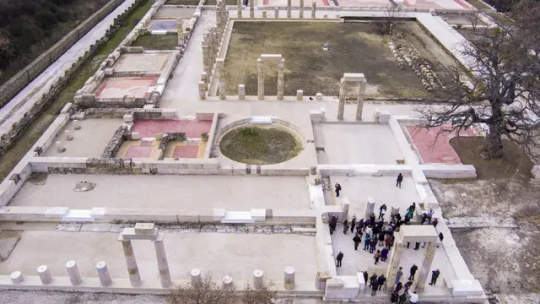
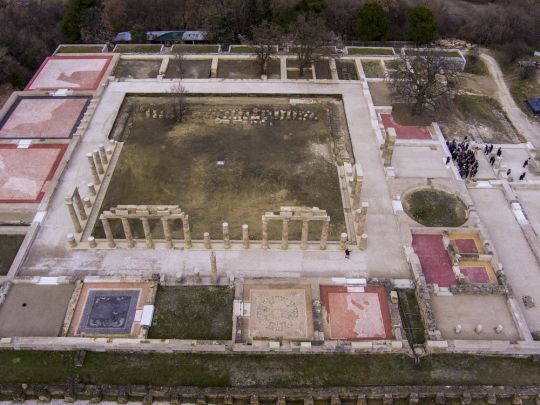
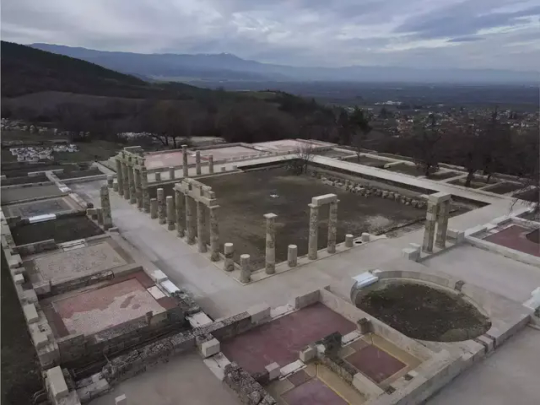
Greece Reopens the 2,400-Year-Old Palace Where Alexander the Great Was Crowned
The 2,300-year-old Palace of Aigai—the largest building in classical Greece—had been under renovation for 16 years.
On the day he was crowned king of Macedonia, Alexander the Great stood atop the intricately patterned marble floors of the Palace of Aigai. This week, the historic palace finally opened to the public after a 16-year-long restoration, report Derek Gatopoulos and Costas Kantouris of the Associated Press (AP).
At 160,000 square feet, the Palace of Aigai was classical Greece’s largest structure. Built primarily by Alexander’s father, Phillip II, in the fourth century B.C.E., it was the home of the Argead dynasty, ancient Macedonia’s ruling family. It was destroyed by the Romans in 148 B.C.E. and endured a subsequent series of lootings. Renovating and excavating this sprawling monument was a serious undertaking, costing over 20 million euros ($22 million).
The Greek government was able to maintain the “general appearance” of the site amid careful alterations to the monument’s towering marble columns, delicate mosaics and textured flooring, according to Xiaofei Xu and Chris Liakos. The palace once featured large column-lined courtyards, worship sites and expansive banquet halls, and its restoration presented a “three-dimensional jigsaw puzzle,” per the AP. Archaeologists solved it by combining stones from the structure’s ruins with replica parts to reproduce the original structures.
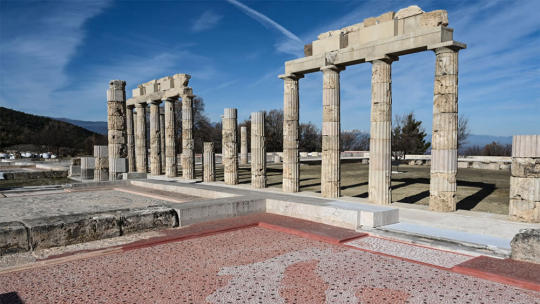
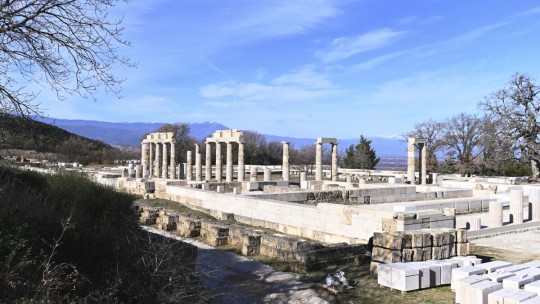
Archaeologist Angeliki Kottaridi started working on the renovation efforts as a university student. Overseeing the project’s progress over many years and contributing to its excavation and reconstruction, Kottardi became a leading figure in the project.
“What you discover is stones scattered in the dirt, and pieces of mosaics here and there,” Kottaridi told state television before an opening ceremony on Friday, per the AP. “Then you have to assemble things, and that’s the real joy of the researcher.”
The Palace of Aigai is located in northern Greece between what are now the towns of Palatitsia and Vergina. Its reopening builds on discoveries made in the late 1970s by Greek archaeologist Manolis Andronikos, who unearthed a cluster of royal Macedonian artifacts, including gold and silver ceremonial weapons and armor, and burials, one of which is thought to contain Phillip’s remains. The palace and its neighboring tombs are now a UNESCO World Heritage site.
Deeming it “among the most important archaeological sites in Europe,” UNESCO writes that the Palace of Aigai “represents an exceptional testimony to a significant development in European civilization, at the transition from the classical city state to the imperial structure of the Hellenistic and Roman periods.”

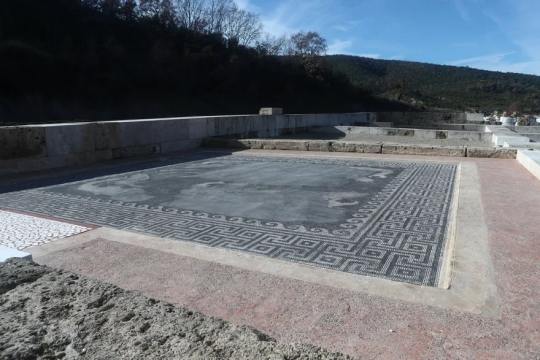
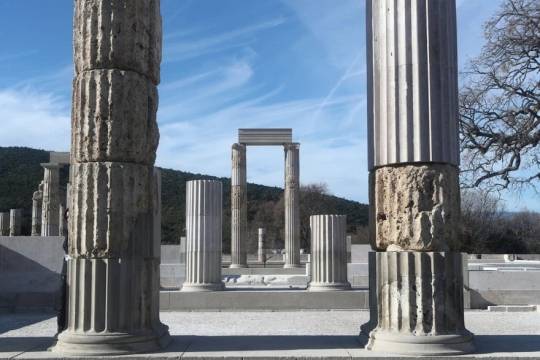
As the site of the first capital of the ancient kingdom of Macedonia, the Palace of Aigai signifies the onset of Alexander’s rule, which would stretch from Asia to the Middle East, and provides a crucial window into Macedonian culture.
“The importance of such monuments transcends local boundaries, becoming property of all humanity,” said Kyriakos Mitsotakis, Greece’s prime minister, at the inauguration event, per CNN. “And we as the custodians of this precious cultural heritage, we must protect it, highlight it, promote it and at the same time expand the horizons revealed by each new facet.”
By Catherine Duncan.
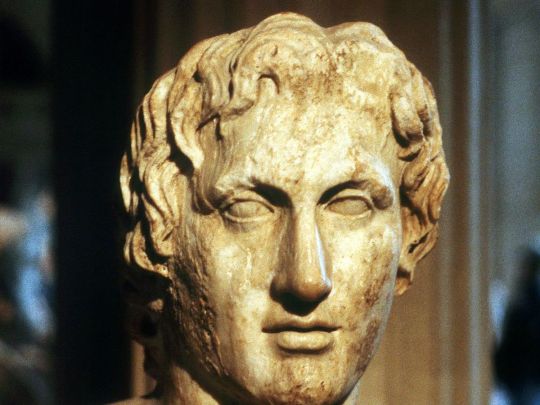
#Greece Reopens the 2400-Year-Old Palace Where Alexander the Great Was Crowned#Palace of Aigai#Argead dynasty#Phillip II#ancient artifacts#archeology#archeolgst#history#history news#ancient history#ancient culture#ancient civilizations#ancient macedonia#ancient greece#greek history#greek art
91 notes
·
View notes
Text
The Past through the Lens of the Future.
Cuthbert Beckett has long been a renowned member of the archaeological community. Having made numerous contributions to the International Archaeological Society of Naples, the European Association of Archaeologists, the Society for American Archaeology, and many more, his impact on the field of archaeology is undeniable. Even so, the elusive archaeologist and historian rarely boasts about his accomplishments. As such, despite his reputation in archaeological and historical circles, he remains a mystery to the rest of the world.
We at Night Owl sat down with him in hopes of getting a glimpse into his exciting life.
"I was always interested in questioning what is considered to be 'common sense' by most people."
Born and raised in England, even in his youth Beckett had a tendency to question what was taken for granted by the people around him. It's no surprise, then, that as he grew up, he became enthralled by history; a science known as much for its diachronism as for its innumerable inconsistencies, as truth blends with legend and legend turns into myth.
His career began in Oxford, where his passion for discovering the truth drew the attention of a then-renowned scholar, who took the young Beckett under his wing and introduced him to his studies. In the following years, Beckett studied meticulously under the guidance of his new mentor, even travelling with him to France, where he remained for a few years before ultimately returning to England.
Of course, for a man such as Beckett returning home rarely means settling down and -encouraged by his mentor- he started his own journey, which would take him the world over.
"[During excavations] I feel pretty much the same as any archaeologist would: like a kid in a sandbox full of really, really precious toys."
Since his time as a student in Oxford, Beckett has inadvertently built a quite the reputation for himself as a paragon and a paradigm to historians and archaeologists everywhere.
His work has taken him all across the globe and back countless times, and his passion for his field of study doesn't seem to have any intention of diminishing, as even today, the struggles involved in the unearthing of humanity's past have the look of fascinating puzzles in his eyes. Of course, much like with a literal puzzle, the illustrious archaeologist's patience is tested every day, as is expected for someone in his field.
Patience, however, isn't the only skill Beckett has developed during his long career.
In the words of the man himself, "[…] the most useful skill I learned over the years is making connections."
Despite the archetype we have in our minds of Indiana Jones or Lara Croft bravely venturing into ancient tombs with nothing but their trusty gear, an archaeologist's job is a social one.
For a start, any good archaeologist has their sources; people who tell them about possible sites, guide them in their search for specific artefacts or even go on-site with them to assist in properly interpreting their findings.
Furthermore, excavations themselves are in no way solitary operations. From professional workers who prepare the dig site and do the actual digging, to specialized architects who draw the layouts of each site, to fellow archaeologists who work together during the excavation, a large number of people have a hand in bringing ancient discoveries to light.
Beyond that, there are museum curators and government officials who oversee the excavations, journalists and interviewers (that's us!) who report on the various operations, and, of course, fellow archaeologists who collaborate to put together the individual pieces they've discovered to reveal the real picture of each 'puzzle'.
As you can see, archaeology is by no means a solitary sport, so along with their investigative skills, professionals must also hone their social skills.
Finally, we all know the old saying, 'Learn from your past.' Be it due to his work, his own experience, or a combination of the two, that is Beckett's advice to our readers.
"If our kind paid more attention to the matters of the past, they'd see the patterns that form in [our lives] over the centuries, and that would definitely help them […] It will be a hard road to walk, but it is worth it."
Eliot Wilde, journalist and writer for Night Owl and host of Night Owl FM
5 notes
·
View notes